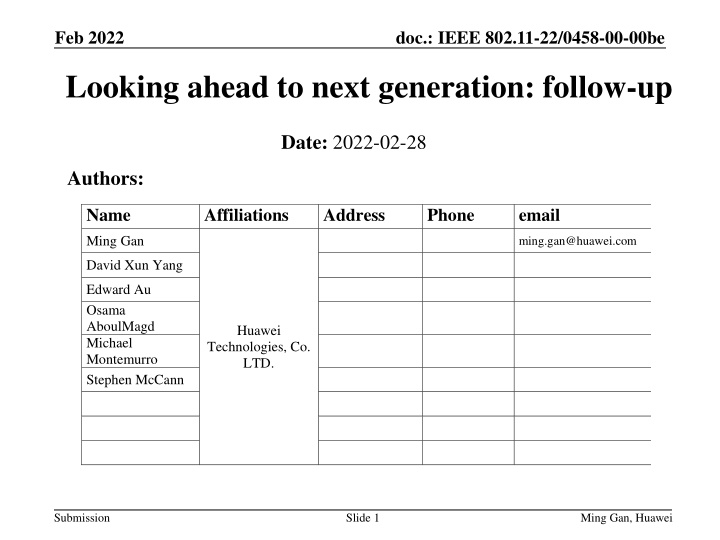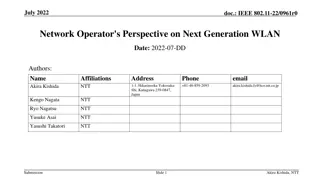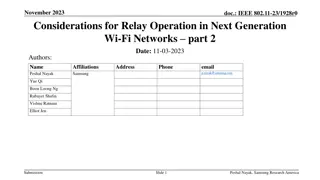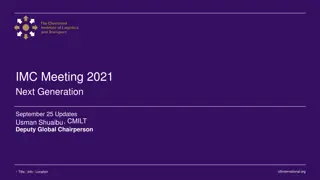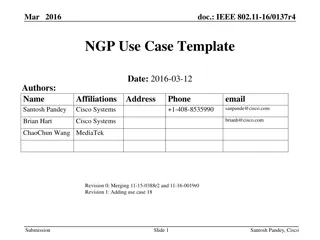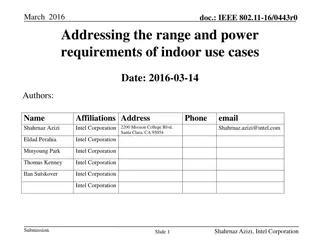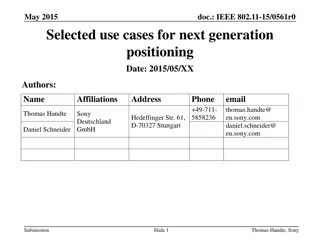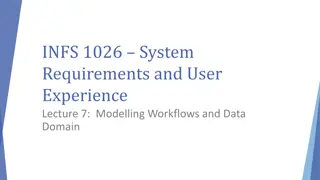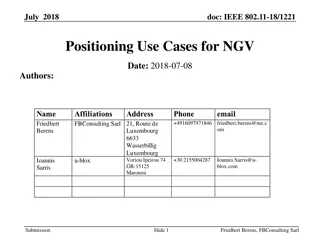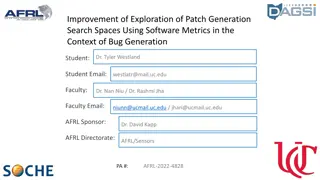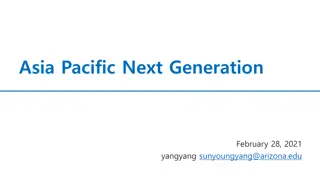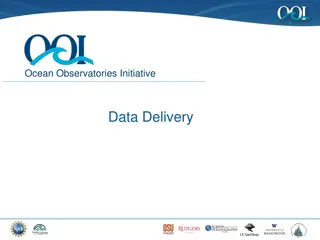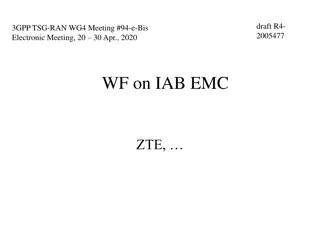Next Generation Wi-Fi: Requirements and Use Cases
"In this document, the focus is on defining high-level requirements for the next generation of Wi-Fi technology, aiming for improved throughput, lower latency, enhanced system efficiency, and better spectrum utilization. The discussion includes the need for new spectrum, potential use cases benefiting from AI, and considerations for incorporating mmwave technology. Explore the evolving landscape of Wi-Fi connectivity beyond current standards, aiming for advancements in performance and reliability."
Download Presentation

Please find below an Image/Link to download the presentation.
The content on the website is provided AS IS for your information and personal use only. It may not be sold, licensed, or shared on other websites without obtaining consent from the author.If you encounter any issues during the download, it is possible that the publisher has removed the file from their server.
You are allowed to download the files provided on this website for personal or commercial use, subject to the condition that they are used lawfully. All files are the property of their respective owners.
The content on the website is provided AS IS for your information and personal use only. It may not be sold, licensed, or shared on other websites without obtaining consent from the author.
E N D
Presentation Transcript
Feb 2022 doc.: IEEE 802.11-22/0458-00-00be Looking ahead to next generation: follow-up Date: 2022-02-28 Authors: Name Affiliations Address Phone email Ming Gan ming.gan@huawei.com David Xun Yang Edward Au Osama AboulMagd Michael Montemurro Stephen McCann Huawei Technologies, Co. LTD. Submission Slide 1 Ming Gan, Huawei
Feb 2022 doc.: IEEE 802.11-22/0458-00-00be Background (1) In the January WNG meeting, we initiated a discussion for next generation beyond 802.11be together with other individuals [1][2][3][4] Provide high level requirements for next generation Propose to form a TIG/SG for next generation in 2022 22/0030r1[1] 22/0032r0[2] 22/0046r1[3] 22/0059r0 [4] 1. Hundred gigabit throughput (new spectrum requirement) 2. Low latency improvement 3. Full Wi-Fi coverage (including roaming and mesh) 4. Intelligent/Capable of Machine Learning 1. Throughput (>2x 11be) 2. Latency (< 1 ms, possibly < 0.1 ms) 3. System efficiency 4. Power consumption 5. Better 6GHz spectrum usage 1. Increased throughput (10Gbps on client with 2 SS, requiring new spectrum) 2. Deterministic operation and reduced latency (better than 0.1ms) 3. Improved mobility 4. Improved coordination of P2P traffic 1. Increase reliability of Wi-Fi connectivity 2. Reduce latency for critical applications 3. Enhance manageability of Wi-Fi networks 4. Reduce device level power consumption 5. Enhance device roaming Experience 6. Improve performance in spectrum congested environments Requir ements Submission Slide 2 Ming Gan, Huawei
Feb 2022 doc.: IEEE 802.11-22/0458-00-00be Background (2) An observation during the discussion in the January WNG meeting is about the lack of new spectrum (e.g., 6 GHz) in some geographic markets. Mmwave was proposed to be taken into account together with sub 7 GHz in [1] [3] so that one device can operate on more bands, which to some extent is aligned with [4] on the spectrum related issue. Submission Slide 3 Ming Gan, Huawei
Feb 2022 doc.: IEEE 802.11-22/0458-00-00be Background (3) Another observation from the discussion is the possible use cases for beyond 11be, which is the focus of this contribution. In this contribution, we focus on two possible areas from our previous submission [1]: Use cases that would benefit from AI Latency related use cases Submission Slide 4 Ming Gan, Huawei
Feb 2022 doc.: IEEE 802.11-22/0458-00-00be Use cases that would benefit from AI (1) As discussed in [1], our Wi-Fi community is currently developing and deploying many new exciting technologies (e.g., multi-user transmission, multi-link operation) that, on the other hand, increases the complexity. Dependencies between the system parameters and their joint optimization usually have a non-linear impact on network performance. Many of these non-linear impacts cannot be easily modeled and optimized without ML (machine learning). Submission Slide 5 Ming Gan, Huawei
Feb 2022 doc.: IEEE 802.11-22/0458-00-00be Use cases that would benefit from AI (2) Taking the channel access as an example, the intrinsic random deferment feature of CSMA/CA makes it upper-bounded by a relative low MAC efficiency [5] suffers from fairness and latency issues in many realistic scenarios Submission Slide 6 Ming Gan, Huawei
Feb 2022 doc.: IEEE 802.11-22/0458-00-00be Use cases that would benefit from AI (3) AI is also getting attention in other SDOs, for example, 3GPP [6] Delay insensitive use cases Delay sensitive use cases Multi-RAT (including mobility, load balancing, RAT selection, PCI selection ,etc) Massive MIMO beamforming optimization (flexible and configurable beam pattern) QoS based resource optimization (at RAN level to fulfill SLS) Channel estimation and channel modelling QoE optimization Traffic steering (guide carrier/band/access preference at per-UE or group of UE granularity) Long-term traffic forecasting and classification can be used in multiple cases, such as flow control, RACH, load balance, etc Link adaptation Beam selection (quick beam selection based on location, etc.) Massive MIMO MAC scheduling (user selection and resource allocation) BS and UE energy optimization IAB topology adaption (congestion and RLF prediction, load balance, etc) Flow control (traffic and UE access prediction) CSI compression MIMO detection Handover Positioning RRM resource ICIC Submission Slide 7 Ming Gan, Huawei
Feb 2022 doc.: IEEE 802.11-22/0458-00-00be Use cases that would benefit from AI (4) The following areas that would benefit from AI are identified for next generation beyond 11be: Delay insensitive use cases Delay sensitive use cases Enhanced handover/mobility Multi-RU/channel allocation (preamble puncture, channel bonding, channel assignment) Latency/QoS optimization Distributed channel access Channel estimation Link adaptation Traffic prediction Beam management MU-MIMO MAC scheduling (user selection and resource allocation) Device level power consumption Spatial reuse CSI compression and feedback MIMO detection Submission Slide 8 Ming Gan, Huawei
Feb 2022 doc.: IEEE 802.11-22/0458-00-00be AI-enabled use cases (1) Use case 1: Channel Access [7] Justification: Reduce access delay and jitter to further improve channel efficiency Input: historical carrier sensing results, historical transmission results, the time duration since last successful transmission, PER, etc. Output: channel access decision (e.g., whether to transmit PPDU or not, transmission packet length) Potential ML algorithm: supervised learning, reinforcement learning Use case 2: User selection for MU-MIMO scheduling [8] Justification: reduce complexity (considering correlation and interference between users) in real-time user selection Input: historical channel matrix, throughput, reported CQI, QoS traffic statistics (latency, packet loss rate), etc. Output: predicted MCS, spatial streams to certain non-AP STA Potential ML algorithm: reinforcement learning Submission Slide 9 Ming Gan, Huawei
Feb 2022 doc.: IEEE 802.11-22/0458-00-00be AI-enabled use cases (2) Use case 3: Roaming [9] Justification: transition delay for roaming in an enterprise network scenario Input: BSS transition parameters (e.g., transition threshold), whether previous transition is successful or not, occurrence of ping-pong after a successful transition, transition failure rate Output: transition decision, new transition parameters (e.g., transition threshold) Potential ML algorithms: supervised learning, reinforcement learning Use case 4: Traffic Steering [10] Justification: Load balancing among multi-link and QoS (latency, reliability) enhancement Input: measurement reports (CQI/BSRP), BSS load statistics, QoS traffic performance statistics (latency, packet loss rate), etc. Output: link transition, enable or disable some links. Potential ML algorithm: supervised learning, reinforcement learning Submission Slide 10 Ming Gan, Huawei
Feb 2022 doc.: IEEE 802.11-22/0458-00-00be Latency related use cases As discussed in [1], the Wi-Fi community needs further optimization on latency because of the many delay-sensitive emerging applications and the increasing deployment of smart IoT, e.g., at home and in factories. Submission Slide 11 Ming Gan, Huawei
Feb 2022 doc.: IEEE 802.11-22/0458-00-00be Latency related use cases in industrial Wi-Fi Besides the interaction among different video screens as mentioned in [1], there are other latency related use cases, such as an industrial network as shown on the right. Now NR is going to be widely deployed in these scenarios. However, there still exists a gap between latency requirements with high reliability and the existing Wi-Fi performance. Industrial PLC control logic high-end terminals Level 1-Non-Real Time: >10ms@99.999% Level 2-Real Time: [2ms,10ms]@99.9999% Level 1 Level 3-Isochronous Real Time: <1ms @99.9999% Production line PLC (level-1 control) Level 1/2 Level 2 Gripper/Soldering Gun I/O Robot PLC (Level 2 Control) Level 3 Servo Driver/Motor PLC density: 30 sets/100 square meters Submission Slide 12 Ming Gan, Huawei
Feb 2022 doc.: IEEE 802.11-22/0458-00-00be Conclusion While continuing pursuing high throughput and low latency for Wi-Fi, like adding mmwave to multi-link framework, it is also important to make Wi-Fi intelligent In this contribution, a few AI-enabled use cases and low latency use cases in Wi-Fi are provided. Submission Slide 13 Ming Gan, Huawei
Feb 2022 doc.: IEEE 802.11-22/0458-00-00be References [1] 11-22-0030-01-0wng-look-ahead-to-next-generation [2] 11-22-0032-00-0wng-next-gen-after-11be [3] 11-22-0046-01-0wng-next-generation-after-802-11be [4] 11-22-0059-00-0wng-beyond-be [5] Giuseppe Bianchi, Performance analysis of the IEEE 802.11 distributed coordination function, 2000 [6] https://www.3gpp.org/ftp/TSG_RAN/WG3_Iu/TSGR3_110-e/Docs/R3-206403.zip [7] Yiding Yu, Soung Chang Liew and Taotao Wang, Non-Uniform Time-Step Deep Q-Network for Carrier- Sense Multiple Access in Heterogeneous Wireless Networks, IEEE TRANSACTIONS ON MOBILE COMPUTING, VOL. 20, NO. 9, SEPTEMBER 2021 [8] Raja Karmakar, Samiran Chattopadhyay and Sandip Chakraborty, Intelligent MU-MIMO User Selection With Dynamic Link Adaptation in IEEE 802.11ax, IEEE TRANSACTIONS ON WIRELESS COMMUNICATIONS, VOL. 18, NO. 2, FEBRUARY 2019 [9] Ismail AlQerm and Jianli Pan, I-HARF: Intelligent and Hierarchical Framework for Adaptive Resource Facilitation in Edge-IoT Systems, IEEE Internet of Things Journal, 2022 Feb 16. [10] Cezary Adamczyk and Adrian Kliks, Reinforcement Learning Algorithm for Traffic Steering in Heterogeneous Network, 17th International Conference on Wireless and Mobile Computing, Networking and Communications (WiMob) 2021 Oct 11 (pp. 86-89). Submission Slide 14 Ming Gan, Huawei
